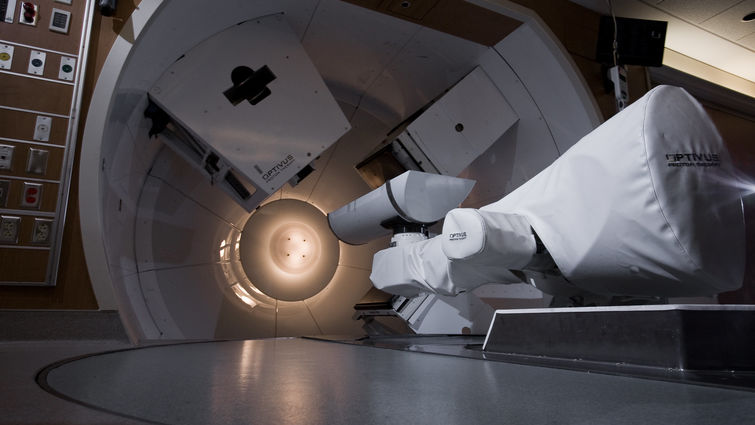

The James M. Slater, MD Proton Therapy Treatment and Research Center has treated more than 10,000 prostate patients with proton therapy since it opened in 1990.
A prostate cancer diagnosis often brings with it a variety of treatment options, and one of the most common discussions involves the differences between radiation therapies. Two of the most prominent options are proton therapy and X-ray therapy, specifically the advanced volumetric modulated arc therapy (VMAT) form of intensity-modulated radiation therapy (IMRT).
Each approach has its unique strengths and potential drawbacks. Radiation oncologist Ivan Namihas, MD, breaks down the key differences between therapies, encouraging a well-informed discussion with your doctor.
What is proton therapy?
Proton therapy is a form of radiation that uses protons instead of X-rays to treat cancer. Protons are subatomic, positively charged particles that stop at a specific depth in the body, allowing them to deliver radiation directly to the tumor with minimal impact on surrounding healthy tissue.
This ability to stop within the tumor is one of proton therapy’s biggest advantages. By not passing through the body, protons help reduce radiation exposure to organs like the bladder, rectum, and intestines. This precision makes proton therapy particularly appealing for prostate cancer, where the tumor is located near several sensitive organs.
"Proton therapy's precision is its biggest advantage," Namihas says. "Because protons can be controlled more accurately, we can deliver higher doses of radiation directly to the tumor while sparing nearby organs. This means fewer side effects and a better quality of life for our patients."
Pros of Proton Therapy:
- Precision Targeting: Proton therapy delivers radiation with high precision, reducing exposure to surrounding tissues. This precision is especially beneficial in prostate cancer, as it minimizes the risk of damage to the bladder, rectum, and other nearby organs.
- Lower Risk of Side Effects: Due to its targeted approach, proton therapy is associated with a lower incidence of common side effects such as urinary incontinence, bowel problems, and erectile dysfunction.
- Potential for Fewer Long-Term Complications: The reduced exposure to healthy tissues also means a lower risk of long-term complications, including secondary cancers.
- Better Quality of Life: Many patients report better quality of life during and after treatment due to fewer and less severe side effects.
Potential Side Effects of Proton Therapy:
- Availability and Cost: Proton therapy is less widely available than X-ray therapy and can be more expensive. However, insurance coverage is becoming more common as evidence of its benefits grows.
- Skin Reactions: Like X-ray therapy, proton therapy can cause skin reactions at the treatment site, though generally milder.
- Urinary Symptoms: While less common than X-ray therapy, some patients may still experience urinary symptoms, such as frequency or discomfort.
- Fatigue: As with any radiation treatment, fatigue can occur during and after proton therapy, although it tends to be less pronounced than with X-ray therapy.
What is X-ray Therapy (VMAT)?
According to Namihas, modern X-ray therapy has advanced considerably over the years, particularly with the development of VMAT (volumetric modulated arc therapy), the latest iteration of IMRT. In VMAT, radiation is delivered in arcs around the patient, providing high precision by focusing radiation beams directly on the tumor while sparing nearby healthy tissue.
"Compared to older styles of 3D or early IMRT techniques, VMAT offers comparable precision to proton therapy in most prostate cancer cases," Namihas says. “VMAT is effective for advanced cases where the tumor may have spread beyond the prostate, making it a more adaptable option in some scenarios."
Although proton therapy is known for its precise targeting, the improvements in VMAT mean that both treatments can minimize side effects for prostate cancer patients. However, the key distinction remains: proton therapy eliminates "exit radiation," which reduces the risk of secondary cancers—a factor that may not be as effectively mitigated with VMAT.
“For most prostate cancer cases, there isn’t a significant difference in immediate outcomes between proton therapy and VMAT,” Namihas says. “But if a patient is concerned about the long-term risk of secondary cancers, proton therapy offers an edge due to its elimination of exit radiation."
Pros of VMAT:
- Highly effective for advanced cases: VMAT’s flexibility allows it to be used for larger or more complex tumors, especially in cases where cancer has spread beyond the prostate.
- Similar precision to proton therapy: With the latest technology, VMAT can achieve comparable results in sparing healthy tissues.
- More widely available: VMAT is available at many cancer treatment centers and is generally covered by insurance.
Potential Side Effects of VMAT:
- Higher risk of secondary cancers: Since X-rays pass through the body, there’s a slightly increased risk of developing secondary cancers over time compared to proton therapy.
- Similar immediate side effects to proton therapy: Fatigue, urinary changes, and bowel discomfort may occur, though these are often manageable.
Which Treatment is Right for You?
When considering X-ray therapy versus proton therapy, weighing the potential benefits and risks of each is essential. Factors such as the stage of your cancer, your overall health, the availability of treatment options, and your personal preferences will all play a role in your decision.
“For early-stage prostate cancer, proton therapy offers exceptional protection for surrounding tissues. But for more advanced cases, I might actually choose VMAT X-ray treatment, which is more adaptable and offers flexibility for complex tumors."
Both therapies are highly effective, and the decision should be made with the guidance of your radiation oncologist, based on your specific diagnosis, cancer stage, and treatment goals.
Key Questions to Ask Your Doctor
- Which treatment is most suitable for my specific stage of prostate cancer?
- What are the expected outcomes and potential side effects of each therapy?
- How will each treatment impact my quality of life during and after therapy?
- Is proton therapy available to me, and is it covered by my insurance?
- What are the long-term risks associated with each treatment option?
Loma Linda University Health experts are committed to providing compassionate, comprehensive, and personalized care throughout your prostate cancer screening journey. Make an appointment for a prostate cancer screening for you or a loved one today.



